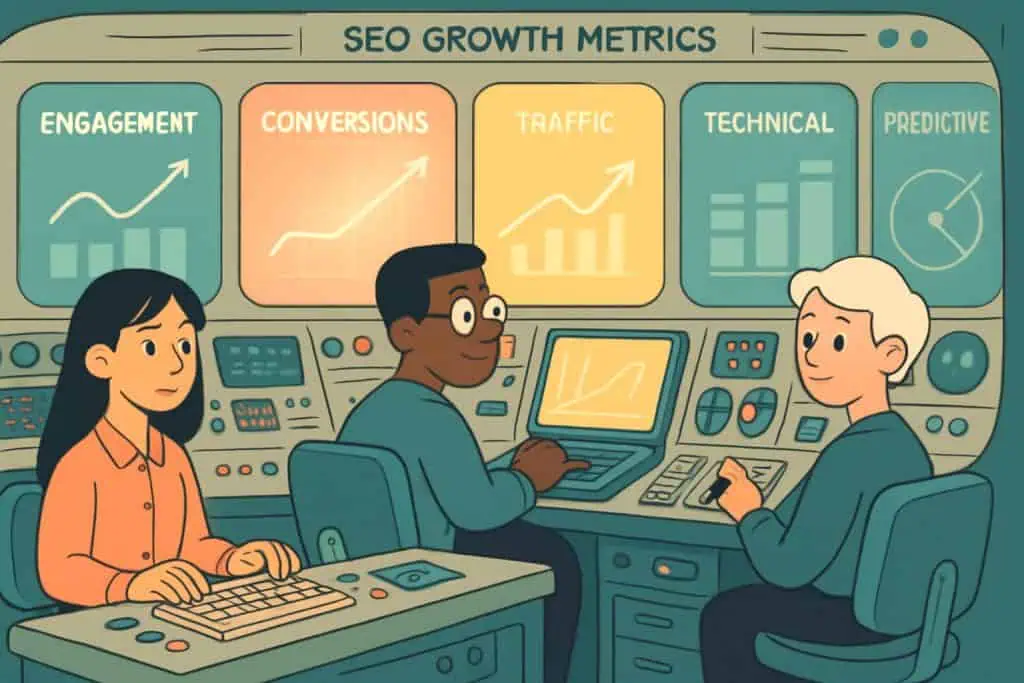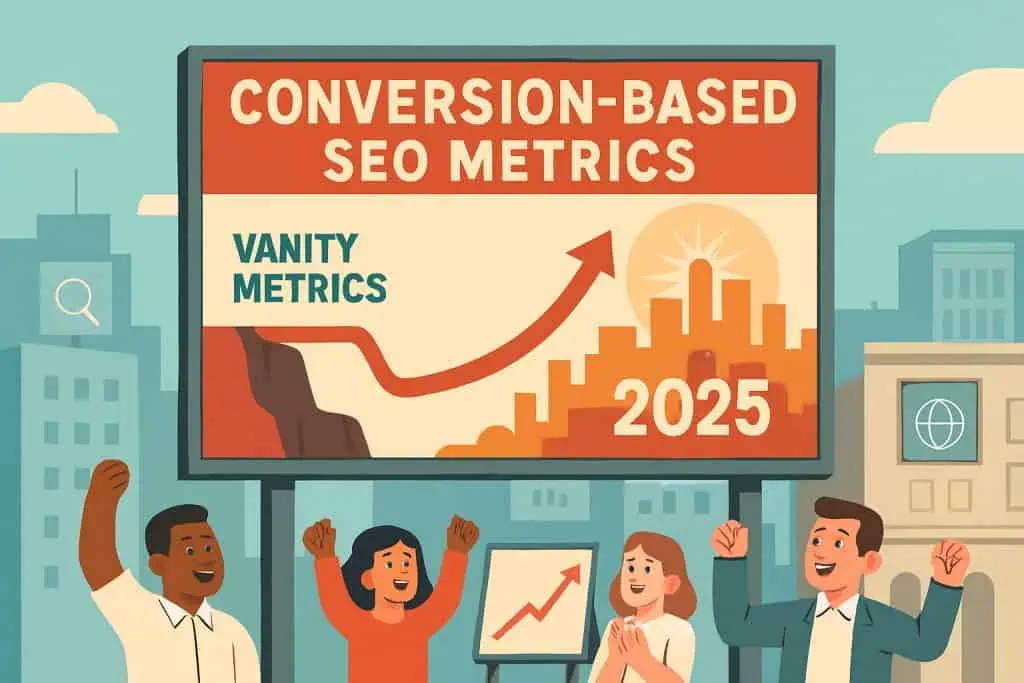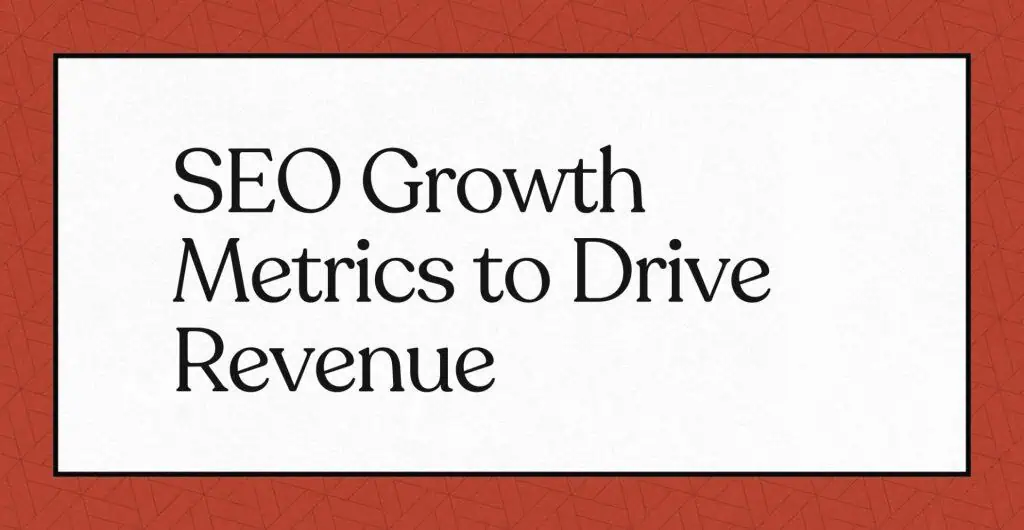Every month, I see clients fixate on keyword positions while ignoring the SEO growth metrics that truly drive revenue. Rankings alone can look good on paper, but without tracking the right SEO growth metrics, you’re flying blind on actual business impact.
Last quarter, one of my e-commerce clients made a pivotal change shifting focus from vanity metrics to SEO growth metrics directly tied to conversions. The result was a 32% jump in sales, even though their top keywords only moved up two spots. That’s the power of aligning strategy with the right SEO growth metrics.
This case proves what too many marketers miss: SEO growth metrics are the bridge between search performance and real profit. When you measure SEO growth metrics like organic conversion rate, average order value, and lifetime customer value, you get a clear, actionable picture of ROI.
If you want surface-level wins, track rankings. If you want lasting business growth, make SEO growth metrics your north star and watch how the right SEO growth metrics turn small shifts into massive revenue gains.
Understanding the SEO Growth Metrics view in 2025
As the SEO industry evolves rapidly, all professionals must stay informed and prepared. In 2025, successful SEO professionals understand that tracking key SEO KPIs is fundamental to creating effective strategies and demonstrating ROI.
These metrics fall into several categories:
- Traffic metrics: Measures of site visitors and their behaviours
- Technical metrics: Indicators of your site’s health and performance
- Engagement metrics: How users interact with your content
- Conversion metrics: Actions that lead to business outcomes
- Predictive metrics: Forward-looking indicators of future performance
While many tools offer dozens of metrics, it’s important to remember that focusing on the ones that align with your specific business goals prevents data overload and ensures meaningful analysis. As one study noted, every metric can become a vanity metric when viewed without proper context. This guidance should give you the confidence to focus on the right SEO metrics.

10 Key SEO KPIs Every Marketer Should Track
When looking to effectively track website performance, these essential metrics provide a comprehensive view of your SEO efforts:
1. Organic Traffic
Organic traffic is one of the core SEO growth metrics for any optimization strategy. This KPI measures visitors arriving through unpaid search results and is a direct reflection of your content quality and overall SEO effectiveness. Without tracking this SEO growth metric, it’s impossible to gauge the true reach of your organic efforts.
For deeper insights, segment this SEO growth metric by:
- Device type (mobile vs. desktop)
- Geographic location
- Landing pages
- Search engines
Monitoring the growth trend of this SEO growth metric over time is far more valuable than looking at a single snapshot. Consistent upward movement in this SEO growth metric reveals the momentum and sustainability of your SEO efforts, showing whether your strategy is producing real, long-term gains
2. Keyword Rankings
While rankings shouldn’t be your only focus, tracking positions for strategic keywords remains crucial. Focus particularly on:
- Top positions (1-3) for high-value keywords
- Ranking improvements for targeted long-tail terms
- Featured snippet appearances
- Local pack rankings (for location-based businesses)
Tools like SEMrush or Ahrefs provide detailed insights into ranking fluctuations and opportunities. Remember that rankings don’t generate revenue—they’re a means of driving qualified traffic.
3. Organic Conversions
This metric bridges the gap between traffic and actual business results. Measuring conversions from organic, whether sales, leads, or other valuable actions, demonstrates SEO’s contribution to business goals.
To properly track organic conversions:
- Set up proper goal tracking in Google Analytics
- Implement conversion tracking for all valuable user actions
- Segment conversions by landing pages to identify high-performing content
- Calculate conversion rates to measure efficiency
4. Page Load Time
Site speed has become increasingly critical for both user experience and rankings. Google’s emphasis on Core Web Vitals makes page load time a technical SEO KPI you can’t ignore.
Monitor load times across your site, particularly for high-traffic pages, and watch for unexpected spikes that could indicate technical issues. Optimizing for speed directly impacts both rankings and conversion rates.
5. Backlink Profile
Your backlink profile remains a powerful indicator of authority and trust. Monitor:
- Total number of referring domains
- Growth of new quality backlinks
- Toxic backlink identification and removal
- Competitor backlink acquisition
- Domain authority trends
Quality consistently outperforms quantity in backlinks, so focus on earning links from relevant, authoritative sources in your industry.
6. Branded vs. Non-Branded Traffic
This distinction is critical for tracking SEO growth metrics that measure your ability to expand reach beyond existing brand awareness. While branded traffic—searches including your company name signals strong recognition, the SEO growth metric of non-branded traffic shows how effectively you capture new audiences searching for the solutions you offer.
A healthy SEO strategy will reflect positive movement in both SEO growth metrics, with non-branded traffic often being the most valuable SEO growth metric for uncovering untapped market potential. Consistent growth here signals that your content and optimization efforts are successfully attracting fresh prospects and widening your audience base.
7. User Engagement Metrics
How visitors interact with your site provides critical feedback on content quality and relevance:
- Bounce rate
- Time on page
- Pages per session
- Scroll depth
- Return visitor rate
These user engagement metrics help identify which content resonates with your audience and which pages need improvement. Low engagement often signals a mismatch between search intent and your content offering.
8. Technical SEO Health
Site errors, crawlability, and technical problems can undermine the best content strategy. Regular monitoring of:
- Indexation status
- Crawl errors
- Site structure issues
- Mobile usability
- Schema implementation
An SEO audit dashboard that highlights errors, warnings, and notices helps prioritize technical fixes that are limiting your site’s performance.
9. Organic Click-Through Rate
Your CTR measures how effectively your search listings attract clicks compared to their impression volume. A declining CTR despite stable rankings often indicates:
- Title and meta-description issues
- Increased SERP competition
- Featured snippets cannibalizing clicks
- Changes in search intent alignment
By tracking CTR changes over time, you can identify optimization opportunities for underperforming pages and respond to evolving search result layouts.
10. Content Performance Metrics
Content-specific metrics help evaluate which topics and formats drive the most value:
- Top-performing pages by traffic and conversions
- Content gaps compared to competitors
- New vs. evergreen content performance
- Topic cluster effectiveness
- Content freshness indicators
With content remaining the foundation of SEO success, these metrics guide strategic content decisions and resource allocation.
Which SEO Metrics Are Most Reliable for Forecasting Website Growth?
Forecasting future SEO performance requires focusing on predictive SEO metrics rather than simply extrapolating past traffic trends. Based on my analysis of successful growth patterns, these metrics offer the most reliable foundation for SEO forecasting:
Keyword Opportunity Index
Calculate the potential traffic value of targeted keywords based on:
- Current ranking positions
- Search volume trends
- Click-through rate potential
- Conversion probability
This methodology helps identify which keywords present the most significant opportunity for growth based on your current position and market conditions.
Competitive Gap Analysis
Comparing your site’s performance against competitors reveals growth opportunities:
- Keywords ranking for competitors but not you
- Content topics with high engagement on competitor sites
- Backlink acquisition rate compared to industry leaders
- Featured snippet opportunities in your niche
This comparative approach identifies specific areas where strategic investment could yield significant returns.
Historical Performance Patterns
Historical data provides context for future predictions:
- Seasonal traffic fluctuations
- Growth rate by content category
- Performance impact of previous optimizations
- Algorithm update effects on your niche
As one source points out, when forecasting SEO for Surfer’s performance over six months, the prediction was only 10.5% lower than actual clicks, demonstrating that accurate forecasting is possible with the right approach.
Traffic Value Metrics
Traffic volume alone doesn’t predict business impact. Instead, focus on:
- Revenue per organic visitor
- Lead value by landing page
- Customer acquisition cost compared to other channels
- Lifetime value of organic customers
These metrics connect SEO performance directly to business outcomes, making forecasts more meaningful to stakeholders and executives.
Vanity Metrics vs. Actionable SEO Metrics: The Critical Difference
One of the biggest challenges in SEO analytics is separating vanity numbers from the SEO growth metrics that truly guide strategic decisions. Impressive figures mean little if they don’t connect to business outcomes, which is why context is everything when evaluating SEO growth metrics.
As one source notes, “Every metric is a vanity metric” without proper framing. The key is focusing on SEO growth metrics that tie directly to revenue, conversions, and market reach, ensuring your optimization work delivers measurable, lasting value rather than surface-level wins.
Common Vanity Metrics to Avoid Overemphasizing
- Raw traffic numbers without conversion context
- Keyword rankings for terms that don’t drive qualified visitors
- Total number of backlinks without quality assessment
- Domain authority as an isolated metric
- Social shares without correlation to business outcomes
These metrics can create the illusion of success while masking fundamental performance issues. While they may look impressive in reports, they often fail to translate into business growth.
Truly Actionable SEO Metrics
Actionable metrics share these characteristics:
- Direct connection to revenue or business goals
- Provide clear insights for optimization
- Reveal actual user behaviors and needs
- Identify specific improvement opportunities
- Enable data-driven decision-making
For example, rather than simply tracking total organic traffic, monitor traffic that converts and understand the factors influencing those conversions. This approach transforms traffic from a vanity metric into an actionable insight.
How to Use KPI Dashboards to Monitor SEO Performance Effectively
Practical SEO dashboard tools consolidate key metrics into visually accessible formats that support informed decision-making. Based on the search results, here are the best practices for implementing SEO dashboards:
Design Purpose-Driven Dashboards
Different stakeholders need different metrics:
- Executive dashboards: Focus on business impact metrics like revenue, leads, and ROI
- SEO team dashboards: Include technical details, content performance, and optimization opportunities
- Client dashboards: Emphasize progress toward specific objectives and value delivered
Customize dashboard layouts to highlight the most relevant metrics for each audience while maintaining a coherent narrative about performance.
Integrate Multiple Data Sources
Powerful dashboards combine data from various platforms:
- Google Analytics and Search Console
- SEO tools like SEMrush, Ahrefs, or Moz
- CRM and marketing automation platforms
- Social media and content performance tools
This integration provides a comprehensive view of performance across the entire customer journey.
Implement Regular Review Processes
Dashboards provide value only when regularly reviewed and acted upon:
- Schedule weekly team reviews of key performance indicators
- Conduct monthly in-depth analysis sessions
- Establish quarterly strategic assessments
- Create automated alerts for significant changes
These review processes ensure dashboard insights translate into strategic adjustments and tactical improvements.
Balance Leading and Lagging Indicators
Effective dashboards include both types of metrics:
- Leading indicators: Predictive measures that signal future trends
- Lagging indicators: Descriptive measures that confirm long-term patterns
This balanced approach supports both proactive planning and performance validation.
Predictive SEO in 2025: Metrics That Anticipate Future Performance
Predictive SEO represents one of the most significant evolutions in search marketing strategy. Rather than reacting to past performance, predictive approaches use data and machine learning to anticipate future trends and opportunities.
Emerging Predictive Analytics Approaches
Several methodologies are gaining traction in 2025:
- Machine learning models that forecast keyword trends based on historical patterns
- Natural language processing to anticipate content topics before they trend
- Competitive intelligence tools that predict competitor strategy shifts
- User behaviour analysis to identify emerging search patterns
These approaches enable SEO professionals to create content and optimize for opportunities before they become competitive.
Implementation Strategy for Predictive SEO
To leverage predictive SEO metrics effectively:
- Collect comprehensive historical data across all relevant channels
- Identify correlation patterns between early indicators and subsequent performance
- Implement tracking for leading indicators specific to your industry
- Develop forecasting models calibrated to your business cycle
- Regularly test predictions against actual results to refine accuracy
One source notes, “Predictive SEO is the process of proactively thinking about what consumers are looking for and providing that information before users need it”.
User Engagement Metrics That Drive Ranking Performance
Search engines increasingly emphasize user experience signals when determining rankings. These engagement metrics provide insights into content quality and relevance:
Critical Engagement Metrics to Monitor
- Dwell time: How long users spend on your page before returning to search results
- Click patterns: Which elements do users interact with on your pages
- Content consumption: How much of your content users actually read
- Return visitor rate: How often users come back to your site
- Search refinement behaviour: Whether users modify searches after visiting your site
These metrics help identify content that truly satisfies user intent versus content that initially attracts clicks but fails to deliver value.
Optimizing for Engagement-Based Ranking Factors
Improve engagement metrics by:
- Creating content that thoroughly answers the primary question plus related questions
- Structuring content for easy scanning and consumption
- Including interactive elements that encourage meaningful engagement
- Designing mobile experiences that facilitate comfortable reading
- Implementing clear navigation paths to related content
The most successful SEO strategies optimize genuine user engagement rather than manipulating surface metrics.
Conversion Rate SEO
The ultimate goal of SEO is driving business results, not just traffic. Conversion rate SEO focuses specifically on metrics that bridge this gap:
Key Conversion Metrics for SEO
- Organic conversion rate by landing page and traffic source
- Assisted conversions where organic search plays a role in the path
- Goal completion rate for specific user journeys
- Micro-conversion tracking for incremental engagement steps
- Revenue per organic visit as a measure of traffic quality
These metrics highlight the actual business impact of your SEO efforts and identify the most valuable traffic segments.
Implementing Conversion Rate Optimization for SEO
To improve these metrics:
- Analyze conversion paths to identify drop-off points
- Segment organic traffic by intent signals and behaviour
- Test landing page variations for high-value keywords
- Optimize for content-market fit based on conversion data
- Align content strategy with the buyer’s journey
This approach ensures that your SEO strategy prioritizes not just any traffic but the right traffic that generates meaningful business outcomes.

Building Your Comprehensive SEO Analytics Strategy for 2025
Bringing together all the elements discussed, here’s how to build a complete analytics framework anchored in SEO growth metrics that directly support business success.
Step 1: Define Clear Business Objectives
- Start by identifying the exact business outcomes your SEO efforts should drive, then align them with the most relevant SEO growth metrics:
- Revenue targets tied to specific SEO growth metrics
- Lead generation goals measured through conversion-related SEO growth metrics
- Market share objectives supported by visibility-based SEO growth metrics
- Brand awareness metrics tracked via impression and reach SEO growth metrics
- These objectives will shape your entire measurement approach.
Step 2: Select Your Core Metrics Framework
- Build a balanced set of SEO growth metrics covering:
- Acquisition metrics (traffic, visibility)
- Behaviour metrics (engagement, content consumption)
- Outcome metrics (conversions, revenue)
- Predictive indicators (leading SEO growth metrics)
- Limit your framework to 10–15 SEO growth metrics to maintain focus and clarity.
Step 3: Implement Proper Tracking Infrastructure
- Ensure accurate measurement of all SEO growth metrics by:
- Configuring analytics platforms correctly
- Setting up event and conversion tracking for core SEO growth metrics
- Integrating data across platforms to unify SEO growth metrics
- Validating tracking regularly to avoid gaps in SEO growth metrics reporting
- Without reliable data, even the best SEO growth metrics framework will fail.
Step 4: Establish Regular Analysis Cadences
- Use a structured review schedule for your SEO growth metrics:
- Weekly tactical reviews of key SEO growth metrics
- Monthly performance assessments highlighting SEO growth metrics trends
- Quarterly strategic evaluations of top SEO growth metrics
- Annual deep dives into long-term SEO growth metrics patterns
Each cadence should answer specific questions and inform actionable steps.
Step 5: Develop Actionable Reporting Processes
- Turn SEO growth metrics analysis into action with:
- Clear visualizations of the most important SEO growth metrics
- Recommendations tied directly to changes in SEO growth metrics
- Prioritization frameworks based on potential SEO growth metrics impact
- ROI projections linked to improvements in SEO growth metrics
- Feedback loops to track changes in SEO growth metrics after implementation
Effective reporting connects SEO growth metrics to real business outcomes, ensuring every insight moves you closer to your goals.
Mastering SEO Metrics for Sustainable Growth
As shown throughout this guide, tracking SEO in 2025 demands a focused commitment to SEO growth metrics—the indicators that truly measure progress and impact. By separating vanity numbers from actionable insights, building comprehensive dashboards, and using predictive analytics, you can turn SEO into a data-driven discipline grounded in SEO growth metrics that fuel consistent business growth.
Metrics alone don’t move the needle. The power of SEO growth metrics lies in the strategic decisions and tactical optimizations they guide. By targeting the right SEO growth metrics, you gain the clarity to drive ongoing improvement and the proof needed to showcase SEO’s real contribution to revenue and market expansion.
As algorithms shift, your measurement methods must evolve too. Staying committed to SEO growth metrics that reflect user value and tangible business outcomes ensures your SEO program remains strong—delivering sustainable growth regardless of algorithm updates or competitive pressure.
Sources
- https://www.ncbi.nlm.nih.gov/pmc/articles/PMC11214926/
- https://contentgecko.io/kb/seo-analytics/seo-kpis/
- https://www.semanticscholar.org/paper/a7a6b539d0e981324aedc8076801322fe08bfb1b
- https://moz.com/blog/vanity-metrics
- https://www.geckoboard.com/dashboard-examples/marketing/seo-dashboard/
- https://agencyeasy.com/calculations-and-metrics-that-help-with-seo-forecasting/
- https://www.shopify.com/blog/seo-kpis
- https://pubmed.ncbi.nlm.nih.gov/30397834/
- https://databox.com/dashboard-examples/seo
- https://surferseo.com/blog/seo-forecasting/
- https://www.ncbi.nlm.nih.gov/pmc/articles/PMC10451891/
- https://trafficthinktank.com/seo-forecasting/
- https://www.semanticscholar.org/paper/496c0a07204285950af328bf04312fed5b273329
- https://www.ncbi.nlm.nih.gov/pmc/articles/PMC11333818/
- https://pubmed.ncbi.nlm.nih.gov/39652282/
- https://www.webfx.com/seo/learn/predictive-seo/
- https://www.forbes.com/councils/forbesagencycouncil/2024/10/08/how-predictive-analytics-is-revolutionizing-seo/
- https://beomniscient.com/blog/predictive-analytics-seo/
- https://originality.ai/blog/what-is-predictive-seo
- https://screpy.com/predictive-analytics-and-seo-a-perfect-match/
- https://pubmed.ncbi.nlm.nih.gov/38609169/
- https://www.ncbi.nlm.nih.gov/pmc/articles/PMC11894353/
- https://www.ncbi.nlm.nih.gov/pmc/articles/PMC11825908/
- https://www.semanticscholar.org/paper/662ee60986d028487b4d06fd970e6645aa03728d
- https://www.semrush.com/blog/seo-kpis/
- https://sitechecker.pro/seo-dashboard/









